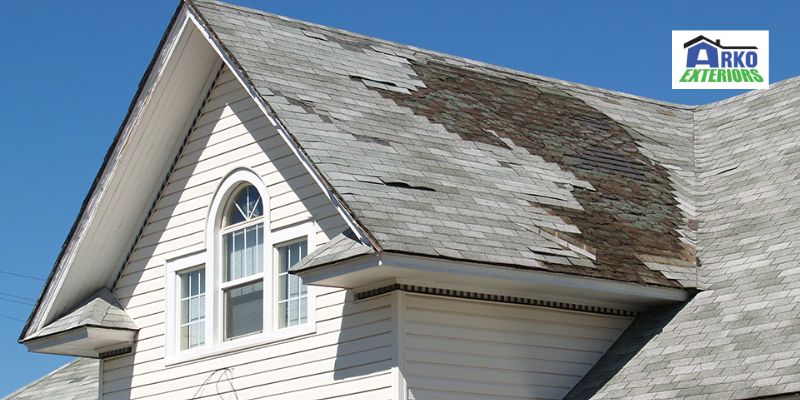Your roof is important to your home because it is its first line of defense. For this reason, you must select the right type of materials, especially against severe weather conditions like storms.
Factors To Consider When Choosing Roofing Materials & Storm Resistance

There are many different types of roofing materials on the market and you can find storm-resistant ones among them. It is essential to choose the right type to enhance the safety of your home. Here are some factors to consider before choosing a roofing material that is storm-resistant…
1. Wind Resistance
Your roofing materials can be affected by strong winds during storms. Therefore, it’s important to choose roofing materials designed to withstand high wind speeds. Some common wind-resistant roofing materials you can choose include synthetic slate, concrete tiles and metal roofing.
In addition to choosing the right type of wind-resistant material, you must ensure that the roof is properly installed. This will help to protect it during storms. It will also add to the long-term durability and reliability of your roofing system.
2. Impact Resistance

When assessing the condition of your roof, its ability to withstand impacts should be a critical factor. Various issues like falling branches, debris and hail can affect your roof. Therefore, you must look for options such as impact-resistant asphalt shingles, metal roofing or synthetic alternatives like polymer-based tiles. These materials stated can absorb and distribute impact. This way, they reduce the risk of damage during storms. By choosing roofing materials with high-impact resistance, you enhance your home’s defense against the effects of extreme weather conditions.
3. Fire Resistance
You should consider fire-resistant roofing materials in areas that are prone to lightning strikes and wildfires. Choosing a Class A fire rating is a great choice when considering protection against fire hazards. These materials can reduce the risk of fire-related incidents.
Note that the Class A fire rating signifies the highest level of fire resistance. By integrating these fire-resistant materials into your roofing system, you enhance your safety and improve your home’s defenses against the threats that come with severe storms.
4. Moisture Resistance
Preventing water infiltration is key to protecting your home from potential damage and structural issues. When choosing roofing materials, consider water resistance to prevent leaks and moisture-related issues.
Furthermore, you can consider options like asphalt shingles, metal roofing or concrete tiles. These materials can form a watertight barrier that effectively prevents moisture formation. By investing in water-resistant roofing materials, you can preserve your home’s durability and longevity.
5. Durability & Longevity
When choosing roofing materials, consider the ones with durability and an extended lifespan. Storm-resistant materials should be able to withstand the harshest elements without wear and tear. Options like synthetic materials, concrete tiles and metal roofing are recommended here. These materials offer the advantage of a longer lifespan when compared to traditional asphalt shingles. You will be making a wise investment when you choose roofing materials that combine durability with longevity.
6. Proper Installation & Maintenance
Most storm-resistant roofing materials cannot perform well without proper installation and maintenance. To ensure optimal performance, ensure that the roofing material you choose is installed by experienced professionals.
Additionally, routine gutter cleaning, regular roof inspections and timely repairs are good practices. These practices play a pivotal role in enhancing a roofing system’s resilience against storms. By investing in proper installation and maintenance, you further protect your roof against severe weather events.
Top Roofing Materials To Consider For Storm Resistance
If you live in a storm-prone area, you must be prepared for harsh weather. Preparation includes selecting the right roofing materials. Here are some of the top roofing materials you should consider to protect your home against storms…
- Metal roofing: Metal roofs are resilient against storms. They are also durable. They can withstand hail, heavy rain and high winds. Metal roofs come in a variety of materials, including copper, aluminum and steel. They are a wise investment for areas subject to storms because of their excellent longevity and fire resistance.
- Asphalt shingles: Asphalt shingles are a budget-friendly choice in areas prone to storms. They offer ease of installation, durability and different styles and colors. When selecting asphalt shingles for such regions, prioritize those with high wind ratings and impact resistance to ensure they can withstand heavy rain, strong winds and hail.
- Concrete or clay tiles: Concrete or clay tiles can offer proper protection against storms. They are resistant to high winds, making them the perfect choice for regions susceptible to hurricanes or tornadoes. Moreover, their longevity and fire-resistant properties enhance their appeal.
- Synthetic roofing materials: Synthetic roofing materials, like synthetic rubber or slate, are good at appearing like traditional materials. They also deliver enhanced durability and resistance to storms. With their lightweight nature, they offer impressive impact resistance and frequently include robust warranty coverage.
- Standing seam metal roofing: Choosing standing seam metal roofs is a great decision to make in regions susceptible to severe storms and strong winds. These roofs have interlocking panels with hidden fasteners and offer exceptional defense against leaks and wind. Their durability means they require minimal maintenance as well.
- Impact-resistant shingles: If you like the classic appearance of asphalt shingles, consider the impact-resistant varieties. These shingles are designed to withstand the force of strong wind gusts. Selecting impact-resistant shingles adds an extra layer of protection for homes situated in storm-prone regions.
Summary:
You should consider different factors before choosing roofing materials if you live in a region with a high occurrence of storms. Prioritize impact resistance, wind resistance and durability. Investing in the right roofing material offers peace of mind in addition to protecting your home against harsh weather conditions.

